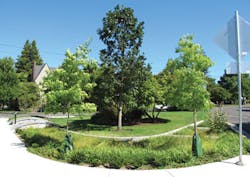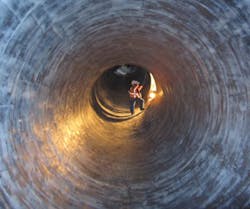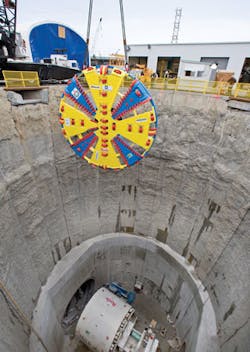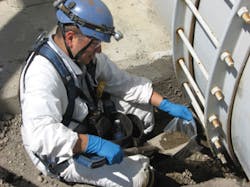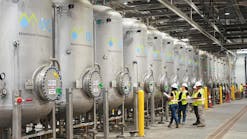By William Atkinson
When it comes to the state of our nation's infrastructure, at least one organization gives most of it failing grades. In its 2013 Report Card for America's Infrastructure, the American Society of Civil Engineers (ASCE) gave a "D" (D-, D and D+) to most types of infrastructure, including dams, drinking water, hazardous waste, levees, wastewater, aviation, inland waterways, roads, transit, schools, and energy.
In its Drinking Water report, ASCE noted that "much of our drinking water infrastructure is nearing the end of its useful life. There are an estimated 240,000 water main breaks per year in the United States. Assuming every pipe would need to be replaced, the cost over the coming decades could reach more than $1 trillion, according to the American Water Works Association."
"As much as 2 trillion gallons of treated water are lost per year," said Dr. Jerad Bales, chief scientist for water with the U.S. Geological Survey (USGS). Of course, the water is not completely ‘lost,' he pointed out, as it eventually returns to the environment. But additional water supplies are needed to make up for the treated water lost from the distribution system. "The amount of water on Earth is the same now as it has been," he said. "The challenge is that there are greater demands on the resource, that water often is not available at the location or the time that it is needed, and that, in some cases, the quality of the water is inadequate for the desired use."
In its Wastewater report, ASCE said that "capital investment needs for the nation's wastewater and stormwater systems are estimated to total $298 billion over the next 20 years." Pipes represent three quarters of that total. The report also noted that, since 2007, "the federal government has required cities to invest more than $15 billion in new pipes, plants and equipment to eliminate combined sewer overflows."
It's not likely anyone would deny that water infrastructure is deteriorating and in need of repair and/or replacement. In fact, upgrading water infrastructure is becoming an urgent priority in many communities. When it comes to upgrading existing water infrastructure, thoughtful, comprehensive and systematic planning makes more sense than launching projects arbitrarily. "We talk to our clients frequently and provide published information to the industry on what we are hearing," said David Egger, managing director, Infrastructure Systems & Programs, Water Division, with Black & Veatch Corp. (www.bv.com). "Part of it is aimed at setting priorities for water infrastructure strategies."
With that goal in mind, there are a number of steps that jurisdictions can and should consider before undertaking certain water infrastructure improvement projects.
1. Create Alignment. According to Egger, the first step is to create alignment. In many instances, various parts of an organization, such as the engineering or operations departments, may attempt to make improvements and tackle this enormous problem on their own. "However, projects need alignment and support all the way to the top," he said. "It is important to get the governing body, whether that be a board or a city council, aligned and committed to a specific level of service."
The most important question to ask here is: What level of service, in terms of performance indicators, are we envisioning for our customers in the future? Examples include leakage rates, minimum pressures, water quality, service interruption, etc.
2. Conduct a Gap Analysis. "No matter what performance indicators you select, you need to start out with a gap analysis," said Egger. Ask yourself: Is there a gap in terms of how we are handling our data? Do we have adequate records? Are they paper or electronic? Do we have an effective GIS program? Then, it's important to understand the gap in terms of the condition of what you currently have. "These systems have been in place for many years and have been under different levels of service," said Egger. For example, pressures may have been higher in the past and the city might have been built around them. It's important to identify what condition your system is in at this point.
"Once you realize your gaps, do a ‘look in the mirror,'" said Egger. "Be brutally honest in determining whether you can do it on your own or whether you need some outside help. What are the attributes that need to be examined to tackle your aging infrastructure?"
3. Assess Other Local Efforts. It is likely that other nearby entities are involved in, or at least considering, projects related to water. It is important to become aware of these and take them into account when planning your own strategy. "In addition to water delivery systems, upgrades to other types of infrastructure can help address water shortages," said Bales. "For example, more efficient irrigation systems are helping to reduce water requirements for crop irrigation, and greater adoption of these systems and continued improvements will affect water availability."
Water is also required to produce most types of energy, so more water-efficient energy production systems and more efficient utilization of energy can help mitigate water shortages.
4. Coordinate with Other Agencies. Before moving forward with your own entity's water infrastructure improvement strategy, try to coordinate it with other agencies that may be involved in the same or similar efforts. An example of this teamwork began taking place in the city of Portland, Ore., in 2005, with the adoption of the 2005 Portland Watershed Management Plan. "This plan lays out Portland's comprehensive, strategic and integrated approach to improving watershed health," said Linc Mann, public information officer for Portland's Bureau of Environmental Services. "Before, there were separate watershed plans for Portland's five watersheds."
The plan adopted in 2005 seeks efficiencies and greater flexibility to find creative, multi-objective solutions that meet multiple requirements and save money. The activities of multiple city bureaus are integrated, maximizing limited resources, and incorporating city values of improving public safety, economic vitality and community stewardship in decision-making.
5. Consider Sustainability Features. According to Joshua Proudfoot, principal with Good Company (www.goodcompany.com), the cost issues associated with adopting sustainability initiatives with water infrastructure projects are a challenge that public agencies should address. "Intuitively, we know that keeping water clean is cheaper than mechanically and chemically treating it after it is contaminated," he said. "What is painful to see is the case being made on a qualitative basis only, when in some places the efficiency of clean water production can be quantified." This, he said, requires paying for good studies.
In fact, while many sustainability features in upgraded water infrastructure can cost money, some can actually save money in the long run, Proudfoot noted. "Water reuse is exciting in that we can reduce the consumption of needed water for other ecological, agricultural and industrial functions," he said. "What is troubling is the resource intensity to get the water to the standards we want. Bit by bit, though, this will come along, especially with the potential for on-site power generation with wastewater treatment plants. The facilities have the potential to generate power from the biogas, low-head hydro and from solar in their settling areas and at their pumps."
6. Assess Funding and Risk. Before determining what funding will be necessary for improved water infrastructure initiatives, it is important to address risk issues, Egger noted. "Incorporating risk into your planning and decision-making process will allow your money to go further than it otherwise would," he said. "For example, some utilities that decide to embark on a replacement program simply decide to replace everything, whether everything needs replacement or not. The mentality is: ‘Our system is 80 years old, so we have to replace it all.'"
According to Egger, this may or may not be true. "Some of the pipe may still be in pretty decent shape, depending on its pedigree and what has happened to it over its life," he said. "In addition, maybe some of the pipe is in a location that, if it breaks, it's not a big deal, in that it doesn't impact service very much." Piping in certain locations may also be easily accessible, thus resulting in a quick, easy and inexpensive repair if it breaks, rather than an automatic replacement beforehand.
7. Consider Technology Opportunities. Infrastructure upgrade and replacement programs are excellent opportunities to consider introducing new, cost-saving, performance-enhancing technologies. "Be ready to embrace analytics and other technologies that have the ability to make your infrastructure smarter," said Egger. Sensors are one example. "Installing sensors and using the information from those sensors to create analytical tools will allow you to make better decisions than you have ever made in the past."
Replacing aging water infrastructure is always going to involve cost, but comprehensive and coordinated planning of the improvements in advance will allow you to get the most for your money.
About the Author: William Atkinson is a correspondent for WaterWorld Magazine. He has been a full-time freelance business magazine writer since 1976, specializing in infrastructure, sustainability, supply chain, risk management, and safety/health.
More WaterWorld Current Issue Articles
More WaterWorld Archives Issue Articles
